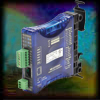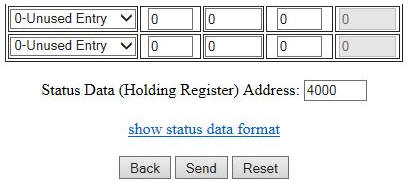Setting Up Automatic Reads
The Modbus Gateway can be setup to automatically read 16 individual blocks of data from the
Modbus/RTU
slaves and store that data in the Modbus Gateway's internal memory. Once the
Automatic Reads table has been configured, the Gateway will continually run
through the entries in the table and process them as quickly as possible. From
that point on, any time the Gateway receives a read request for
data that is automatically being read, the Gateway will return the data from
it's internal memory instead of issuing a read request from the Modbus/RTU slave. If
the read request is for data NOT being automatically read, the Gateway will
issue a read request for the data from the Modbus/RTU slave and return that data in the
TCP/IP response.
Memory to Read
Select one of the four available memory types to read (Coils, Discrete
Inputs, Holding Registers or Input Registers)
Slave Number
The Unit ID of the Modbus/RTU slave from which to read the data.
RTU Start Address
The Offset in the Modbus/RTU slave of the data to read.
Number of Elements
The number of elements of the specified memory type to read from the Modbus/RTU slave.
- The maximum number of Coils or Discrete Inputs in a single automatic
read is 2000.
- The maximum number of Holding Registers or Input Registers in a
single automatic read is 125.
Gateway Memory Address
This field displays the starting location of the data from the automatic
reads in the Gateway's internal memory. By default the Gateway will store the
data from the individual automatic reads for the same memory types in
consecutive location in the Gateway's internal memory.
For example, assume there are are two automatic reads configured to read 16
coils from each of two slaves, the Automatic Reads table would look like this:
| Memory to Read |
Slave Number |
RTU Start Address |
Number of Elements |
Gateway Memory Address |
| 1-Coils |
1 |
0 |
16 |
0 |
| 1-Coils |
2 |
0 |
16 |
16 |
The last column tells you that the Coil data from Modbus/RTU slave 1 will be stored
in the Gateway in coil locations 0-15, and the Coil data from Modbus/RTU slave 2 will
be stored in the next 16 coil locations in the Gateway which are 16-31.
The advantage of having this data is stored in consecutive data locations in the
Gateway's internal memory is the ability to read all 32 of these coils in one request by specifying
the Unit ID of the Gateway as the RTU slave in the read request. Using the above
example, reading 32 coils beginning at offset 0, from the Unit ID of the Gateway
itself would return the 16 coils from Unit ID 1 and the 16 bits from Unit ID 2
in a single transaction.
Gateway Modbus Address
This is the Unit ID of the Modbus Gateway itself. The Unit ID of the Gateway
is set by NetEdit (v3.8 or later).
Auto Assign Gateway Addresses
If checked, the Gateway will automatically assign the internal memory
locations for data from Automatic Reads. If unchecked this allows the user to
manually assign the location on the Gate way to store the data. Care must be
taken not to allow the data from different Automatic Reads to overlap in the
Gateway's internal memory. If you do specify an Automatic Read that will create
overlapping data, the value in the Gateway Memory Address field for that Read
will be displayed in the color red.
For example, you could manually assign the internal address beginning
location for slave 1's data to 100, then slave 2's data to begin at 200, etc.
| Memory to Read |
Slave Number |
RTU Start Address |
Number of Elements |
Gateway Memory Address |
| 1-Coils |
1 |
0 |
16 |
100 |
| 1-Coils |
2 |
0 |
16 |
200 |
|




